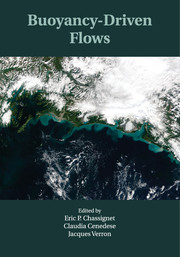Book contents
- Frontmatter
- Contents
- List of Contributors
- Introduction
- 1 Gravity currents – theory and laboratory experiments
- 2 Theory of oceanic buoyancy-driven flows
- 3 Buoyancy-forced circulation and downwelling in marginal seas
- 4 Buoyant coastal currents
- 5 Overflows and convectively driven flows
- 6 An ocean climate modeling perspective on buoyancy-driven flows
- 7 Buoyancy-driven currents in eddying ocean models
- 8 Atmospheric buoyancy-driven flows
- 9 Volcanic flows
- 10 Gravity flow on steep slope
- Index
- Plate section
- References
6 - An ocean climate modeling perspective on buoyancy-driven flows
Published online by Cambridge University Press: 05 April 2012
- Frontmatter
- Contents
- List of Contributors
- Introduction
- 1 Gravity currents – theory and laboratory experiments
- 2 Theory of oceanic buoyancy-driven flows
- 3 Buoyancy-forced circulation and downwelling in marginal seas
- 4 Buoyant coastal currents
- 5 Overflows and convectively driven flows
- 6 An ocean climate modeling perspective on buoyancy-driven flows
- 7 Buoyancy-driven currents in eddying ocean models
- 8 Atmospheric buoyancy-driven flows
- 9 Volcanic flows
- 10 Gravity flow on steep slope
- Index
- Plate section
- References
Summary
Ocean models are based on the conservation of vector momentum, and scalar tracers, which give time evolution (prognostic) equations for the velocity field, the active temperature and salinity tracers, and all passive tracers of interest, such as oxygen, carbon dioxide, and nutrients. In contrast, ocean density, ρ, is diagnostic and not necessarily conserved. It is computed from the active tracers using an equation of state (EoS). Griffies (2002) and works cited therein discuss the approximations leading to the primitive equations that are typically solved by climate models, and common ways that the global ocean is discretized. Various methods of integrating the equations are also presented, along with their advantages and disadvantages. Asummary, including the equations themselves, is provided in Treguier et al. (Chapter 7, this volume). The existence of such excellent references means that this chapter can focus on specific illustrative examples of the workings of buoyancy in particular ocean models, without being comprehensive, or repeating the background.
The great challenge of climate modeling is the roughly 10-decade-wide range of potentially important interacting scales; from the more than 107 m global scale to the less than 10-2 m viscous scale. Present coupled climate calculations are reaching down to the 104 m horizontal and 10 m vertical scales in the ocean, but still many subgrid scale (SGS) processes and interactions rely on parameterizations. In principle, model fidelity should benefit from increased resolution. Indeed, improvements can be dramatic.
Information
- Type
- Chapter
- Information
- Buoyancy-Driven Flows , pp. 240 - 280Publisher: Cambridge University PressPrint publication year: 2012
